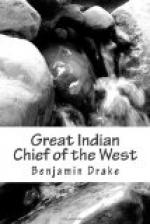“A Mr. Chancellier had gone on the day of attack, to the prairie for strawberries, with his wife, two daughters and an American, the first that had ever been in the country, in a cart drawn by two horses. When they perceived the Indians, they immediately fled towards the town in the cart; Mr. Chancellier being seated before, and the American behind, in order to protect the women, who were in the middle. In their flight the American was mortally wounded. As he was falling out, Mr. Chancellier seized him and threw him into the midst of the women, exclaiming, “they shan’t get the scalp of my American.” He was at the same time struck by two balls, which broke his arm in as many places, above the elbow. His wife received a bullet through the middle of her hand, the elder daughter was shot through the shoulder, immediately above the breast, and the younger was struck on the forehead, but the ball glanced aside and merely stunned her. The moment Mr. Chancellier arrived at the gate, his horses dropped dead, pierced with a hundred wounds, but his family was saved.”
Mr. Primm, the writer of this interesting narrative, has probably not been fully informed in regard to the extent of Colonel George Rogers Clark’s participation in this affair. In a written memorandum now before us, made on the authority of his brother, General William Clark of St. Louis, who it is presumed has possession of his father’s official papers, it is stated, in reference to this affair, that although the Spanish Governor could not be made to believe that an attack was intended, the principal inhabitants sent over an express to Colonel Clark, who was then at Kaskaskia with five hundred men, to come and protect them. He accordingly marched his force up opposite the town and encamped a little distance from the river. He did not send over any troops, but was to do so, in case of an attack; when it was actually made Colonel Clark crossed the river; and upon seeing the “long knives,” as the Indians called his troops, they hastily retreated, having killed seventy-two or seventy-three of the Spaniards, before his arrival. This sudden appearance of Colonel Clark, upon the scene of action, explains the conduct of the Indians. So large a body of warriors, making a preconcerted attack, upon a town but badly protected, would not, it is thought, have given up the assault so suddenly and before they had lost a single man, unless alarmed by the presence of a superior force. On the supposition that Colonel Clark actually crossed the river with his troops, the flight of the Indians is easily explained. They were probably apprised of Colonel Clark’s being at Kaskaskia, and his name was every where a terror to the Indians. As an evidence of this, a short time afterwards, he sent a detachment of one hundred and fifty men, as far up the country as Prairie des Chiens, and from thence across Rock and Illinois rivers and down to Kaskaskia, meeting with no molestation from the Indians, who were struck with terror at the boldness of the enterprise, saying that if so few dared to come, they “would fight like devils.”




